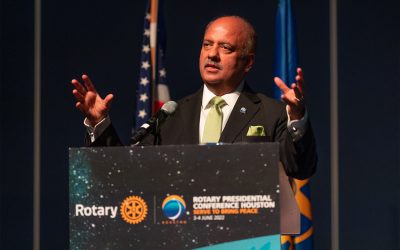In July 1919, eight months after Armistice Day, The Rotarian printed its Gold Star Roll of Honour, listing members “who gave their lives in the service of their countries and humanity.”
It contains the names of 47 Rotary members: twenty-six were from the United States, nine from Canada, eight from Scotland, and four from England — and there were at least six more members whose names should have appeared on the honour roll but did not.
There were no Rotary clubs in continental Europe or Australia until after the war.
Captain Richard Steacie was the first Rotary member to die in the war.
A member of the 14th Royal Montreal Regiment, Steacie was shot through the neck on April 22nd, 1915, during the Second Battle of Ypres in western Belgium.
The dead soldier’s collar tag identified his rank and regiment but not his name, and he was buried beneath a gravestone inscribed: “A Captain of the Great War … Known Unto God.”
Steacie’s body was finally identified in 2013.
All the honour roll tells us of J.N. Henderson is that he was from Edinburgh, but a monument inside that town’s St. Giles’ Cathedral notes that he was a major with the 4th Royal Scots who died on June 28th, 1915, at the battle of Gully Ravine on the Gallipoli peninsula in Turkey.
Another Edinburgh soldier, Lieutenant W.E. Turnbull of the 5th Royal Scots, also died at Gallipoli. Private C. Taylor of the 7th Manchester Battalion remains an enigma; he didn’t make the 1919 honour roll, but the December 1915 issue of The Rotarian mentions his death.
Not every Rotary member soldier died on the battlefield.
Robert M. McGuire, a photographer from Joplin, Missouri, died on July 4th 1918 “from [an] operation to prepare him physically for entering service.”
George Blakeslee of Jersey City, New Jersey, died of unknown causes October 2nd, 1918 at Camp Johnston, Florida.
Frank Keator of Kingston, New York, died of pneumonia at Camp Devens, Massachusetts, on December 29th, 1917.
Orders for the new Rotary pin commemorating the centenary of the end of WW1, will be taken at next week's business meeting. They cost £3 each and all profits go to the Royal British Legion.#poppy #rotary #britishlegion pic.twitter.com/cmu7DI9pBe
— Thirsk Rotary (@rotary_thirsk) August 17, 2018
Two other members also died of pneumonia, and in a harbinger of the global epidemic, Captain Eugene H. Kothe of the Quartermaster Corps died of influenza in Washington, D.C., on October 14th, 1918.
A star half-back at Kalamazoo College, Colonel Joseph B. Westnedge fought in the Spanish-American War, served on the Mexican border after Pancho Villa raided Texas and New Mexico, and led the 126th Infantry in the renowned 32nd “Red Arrow” Division during key offensives in France during World War I.
On November 29th, 1918, in a hospital in Nantes in France. Westnedge died of complications from tonsillitis.
His name is missing from the Roll of Honour.
For Rotary members, the heaviest toll in battle came in 1918 after U.S troops landed in Europe.
Most fatalities came in the seven-week Meuse-Argonne Campaign that breached the Hindenburg Line, Germany’s last line of defence.
Lieutenant Harry B. Bentley of Elmira, New York, died on September 29th near the St.-Quentin Canal; Lieutenant Edward Rhodes of Tacoma, Washington, died nearly two weeks later near Grandpré. Today, Bentley and Rhodes have American Legion posts named for them in their home states.
On October 22nd, Private Jacob Ferdinand Speer of Wilmington, Delaware, whose name also does not appear on the honour roll, died near the bombed-out Madeleine Farm north of Nanti-llois.
And on November 4th, a week before the war ended, Corporal Howard E. Brown of Lincoln, Nebraska, died in the advance on Stenay, a village on the Meuse River.
The last Rotary member known to have fallen in combat during the War to End All Wars, Brown had written to a member of his Lincoln club a few weeks earlier to thank him for forwarding “next year’s membership card.”
But Brown was not the final fatality. That distinction belongs to Griffin Cochran of Lexington, Kentucky.
Before the war, Cochran provided updates about Rotary happenings in his hometown.
As a club correspondent, he was, as the editors explained, one of the many “service-men whose co-operation makes our magazine successful.”
Because this note appeared in 1916, the reference to service-men likely had no military association but instead referred to club members who assisted “The Magazine of Service,” The Rotarian’s slogan at the time.
In the spring of 1918, Cochran was a captain at Camp Zachary Taylor near Louisville. Cochran’s unit, the 309th Ammunition Train, eventually found its way to France, where it remained after the war ended.
On February 21st, 1919, Cochran died at Tours. His cause of death remains a mystery.










